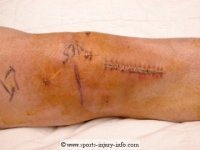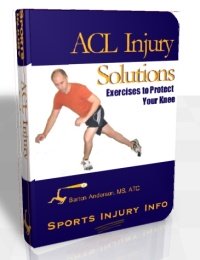ACL Reconstruction Timeline

After an ACL reconstruction, you will begin a long acl rehab process. While you may not be in formal rehabilitation for 6-8 months, you will have to do things on your own to build your strength, endurance, balance, and sports skills.
The ACL rehab process spans several months, some of which can be filled with frustration. The first several weeks see lots of progress, with almost daily gains in range of motion, strength, and function. The following months have less noticible gains.
Weeks 1-6
During the immediate post-operative phase after ACL reconstruction you will be
doing exercises at home, as well as attending rehabilitation at a
clinic. It is extremely important that you undergo rehab in a
supervised and formal setting.
In the first few
weeks, I work
with my patients to restore their range of motion, strength, and
balance. I work with them on their gait, and walking without a limp.
My
goals for all of my ACL reconstruction patients include the following:
- Full active extension and 90 degrees of flexion in 1 week
- Off crutches in 2-3 weeks
- Pain levels of 0-1/10 with all daily activities in 3 weeks
- Ability to walk up and down stairs comfortably in 4 weeks
- Out of the post-operative brace in 3-4 weeks
- Driving in 4 weeks (manual transmission, right leg surgery)
- Discharge to a home program to continue strengthening
Returning
range of motion, especially active extension is the first priority for
ACL rehab. With full active extension, you will be able to walk
normally, and your swelling and pain will diminish much more quickly.
It is the most important goal.
Most people worry
about being
able to bend their knee. This motion will come back, but it does so
much more slowly. As you continue to get stronger, it will improve.
Weeks 7-12
My
patients continue to work on strengthening at home, and I update their
programs every 3-4 weeks. This is important to make sure that they are
progressing, and that they are not having any problems or setbacks.
I
won't get into the specific exercises that I have patients do, but I
progress them to jogging at 12 weeks. By this time, they have little to
no pain with daily activities, and are walking normally without the
brace.
Once they start jogging at 12 weeks, the
process
plateaus. You don't see any major timeline goals, and you just have to
keep plugging away with your strengthening.
4 Months Post Op
At
this time after the ACL reconstruction I start my patients on jumping
activities. Specific exercises that are designed to get the knee used
to the loading and unloading of jumping. Patients continue with their
strengthening and jogging, and add jumping activities to the program.
This
is the most frustrating time of the ACL rehab process. You don't see
much tangible progress day to day. You will be gaining strength and
balance, but it isn't like the first few weeks when you notice an
improvement everyday.
5 Months Post Op
At 5 months after ACL reconstruction, I start my patients on hopping drills. These are similiar to the jumping drills, but on just one leg. It progresses them to sports specific drills, and gets them ready for eventual return to play. They are working on higher level strengthening exercises like single leg squats, Romanian dead lifts, and other functional exercises.
6 to 9 Months Post Op
Most of my patients are able to return to full sports activities at 6 months. Some take a little longer to get back into the swing of things. The general concensus from our physicians is 6 months after surgery being the earliest they will return anyone to unrestricted activity.

Bridging the gap between one on one rehab and return to play can sometimes be difficult. You may be given a home
program, with some exercises to work on, but often times, you are left to continue strengthening on your own.
The problem is that these home programs often don't progress you as far as you need to be before you return to sports. Which means that
you are at risk for re-tearing once you do return. The final stages of rehab must contain exercises that train your body
to prevent a re-tear of the ACL. Strength, balance, and muscle control are the key components of the last 2 months of rehab before release.
A Complete Prevention Program
ACL Injury Solutions is a comprehensive 8 week program designed to help protect your ACL. It includes all of the best exercises for improving muscle control, balance, strength, and mobility - the same exercises I use with my own patients in their last months of rehab. If you are recovering from an ACL tear, are 4-5 months out from surgery, and want to be as strong as possible when you are released for sports, ACL Injury Solutions is for you.
ACL Surgery Stories
If you have had an ACL reconstruction, or are getting ready for this surgery, I want to hear your story. Whether you have questions you want answered, or just want to share your experience, this is the place for you.
Summary
ACL
rehab is a long process. It helps to be able to see the goals along the
way, and to know when you will be able to do specific things...like get
off your crutches, get out of the brace, start jogging, jumping, and
return to play.
Discuss with your surgeon their
specific ACL
reconstruction timeline. It may be different from the one above, it may
be very similiar. Knowing when and how you should progress will set
your mind at ease, and give you something to work towards.
Running Pain Solutions
Written for Runners by a runner, you'll learn a holistic approach to improving mobility, restoring normal movement and muscle activation patterns, and restoring the body and mind connection.
This Kindle Book contains a step by step program to keep you running pain free. Included are detailed instructions and illustrations for exercises to improve mobility, balance, neuromuscular control, strength and endurance. Only $7.49!
Get Your Copy Today!









